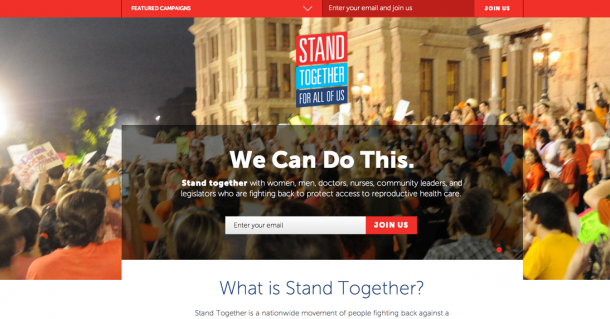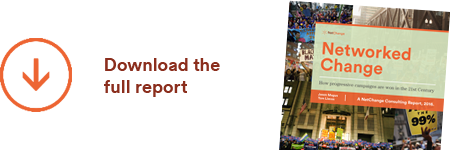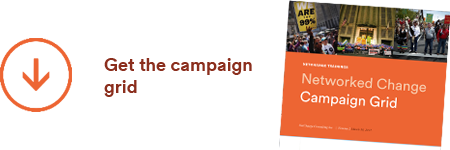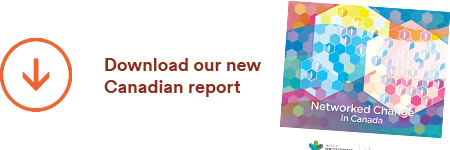Some of the most exciting work I get to do is campaign planning: taking a group with a vision and some resources and helping them focus a tight communications, engagement, and digital strategy that’s going to help them win.
Sometimes people want to start right away with a tactic – they like someone else’s website/video/tool and want to be similar. But before you decide what the digital part of your campaign will do, you need to be clear on the things your campaign will be doing first. Are there protests? Are you doing PR or ads? Are you knocking on doors?
Here are three very different styles of campaigns, and some examples of world-class campaign websites they’ve made, to help get you inspired.
Memes & Media: The PR / Comms Campaign
Fast paced campaigns to influence a decision maker and the pubic debate. Strong content and GR strategy, low supporter engagement.
The classic “air war” campaign aims to create the perception of a mass public outcry for or against an issue and present that to decision makers. These campaigns are typically slick, branded, and built around a core piece of content (a report, policy paper or plan), which today has to be very visual and grossly simplified.
They have strong storytelling and a heavy investment in PR, as well as advertising if they can afford it. Rapid response is king. Behind the scenes, effort on government relations, influencer and grasstops endorsements, strategic polling, and high level media work are constantly happening.
These websites typically offer supporters only simple actions and low engagement, they are thus a great fit for the majority of campaigns with no real world actions or local leadership to support. While the truth is it’s difficult to get big numbers in this kind of campaign, if your one hit wonder catches on, you win.
Wicked examples:
- Enbridge 21: site + ad campaign to brand damage 21 political leaders as being on the wrong side of an issue important in their province
- The Solutions Project: site to popularize and build momentum around a radical idea and powerful dataset
- Nature Is Speaking: super slick storytelling site from CI to change the way we think about nature and harvest emails
- Pick a campaign site you like. Any campaign site. It’s probably one of these. Most are.
People & Data: Organizing campaigns
Labour intensive, slower growth, but with deeper relationships. Hyper politically targeted. Require a long view.
A friend in DC recently told me that three years ago all the top young grads wanted to be digital directors. Today they want to be organizing directors. The realization that certain movements (ahem) blew millions on policy and air war campaigns with little political power to show for them has made building real people power cool again.
Building a real support base is labour intensive, and you can’t really fake it. Organizing campaigns require a sizeable (if lower cost) staff infrastructure, or a devoted volunteer corps to meet or phone real people. Staff have a focus on systems, training, and support to others who are on the front lines.
Data lies at the core, so they require a much heavier investment in tech, with intensive custom set up, maintenance, and reporting needs. Websites are typically more bare bones, simple and cheap, with minimal storytelling and not much fancy visual content.
What these campaigns do have is a compelling ask and theory of change – honed at hundreds of doorsteps or tested online with thousands of members. Language that really moves people. Eventually, unless you are a union (and even that’s changing), these campaigns require listing to and giving supporters real power in order to sustain long term engagement. Tricky work.
Wicked examples:
- Common Sense Action: high energy movement building site with clear engagement pathways to local chapters and gamified participation
- Stand Together: passionate and beautiful site by the ACLU that is thin on content but supports an active 4 state campaign
- Ecology Ottawa: Simple, low-cost Nation Builder site to build political power around environmental issues in a specific region
- Pretty much any site or action from Avaaz, SumOfUs, LeadNow, or Presente.org: bone simple, hyper optimized for conversions, with clear compelling (and tested) theory of change language.
The Holy Grail: Integrated Campaigns
Real world actions plus strong comms and PR work, requiring a deep expertise and investment in both disciplines.
Some rare campaigns are marrying the best of air and ground wars together into a beautiful and powerful whole. Offering real world engagement or leadership opportunities, amplified by strategic comms and PR work, all aiming towards a big hairy goal.
Sounds pretty cool eh? In reality these campaigns require a mastery of and serious investment in two difficult and traditionally very separate worlds or comms, organizing, and digital. A highly collaborative culture of experimentation, metrics-driven decision making, and impact is key, as is a senior leadership who understands, values, and thus supports equally both disciplines.
Integrated campaigns require a longer view of building real power, not just winning a campaign, but looking good while doing it. They are not culture or politics, but both and. And I think they are the future.
Wicked examples:
- Beyond Coal Texas: hands down the best story I’ve heard about how digital, comms, and organizing worked together to find powerful volunteer leaders to put out front and win big
- Idle No More: Canadian born Indigenous rights movement with epic storytelling (doing much needed education) and mobilizing people to action and events
- Most recent campaigns of Greenpeace, including VW Dark Side and Save the Arctic with epic storytelling, well designed supporter engagement, and smart PR and insider lobbying work
- Vision Vancouver: compelling visual storytelling with clear engagement pathways and a sense of community
Network Campaigns?
There is a fourth model that I very much love but won’t quite make this list. Network campaigns are a newer and exciting model, most appropriate in an environment where a lot of medium to high profile partners are already making an impact on an issue but need to tie their messaging together more and get a boost to put them over the top. I’ve worked on these a lot and will do more writing in a future post.
The campaign style you choose will depend on your issue and goals, your audience and how fired up they are, your culture and staff, your database and technical chops. While I have preferences, this research shows there isn’t one right way to get to awesome as long as you’re clear on what you want and honest with what you’re capable of.










